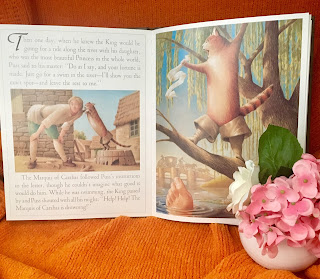Puss in Boots
 |
| Unfortunately, the dust jacket was missing from the book, so there was not an illustration on the actual cover. |
Puss in Boots
By: Charles Perrault
Translated by: Malcolm Arthur
Illustrated by: Fred Marcellino
Genre: Traditional Literature
Major Awards: Caldecott Honor (1991), American Library Association Notable Children's Books, Publishers Weekly Best Children's Books of the Year
Grade Level: Pre-K-5
Summary: When a miller died, he left behind his three sons and his mill, donkey, and cat. The brothers divided up what was left: the oldest got the mill, the middle got the donkey, and the youngest got the cat. The youngest was worried that he would not be able to make a living and would starve to death, until Puss came to his rescue. He asked the man for a pair of boots and a sack, and told the man that he would take care of all his troubles. The cat then hunts and continuously brings his prey to the King. Each time, he says that the offerings are from the Marquis of Carabas (Puss' owner). On the day that the King took his daughter for a ride, Puss tells the man to swim in the river. When the King and his daughter pass by, Puss yells out that the Marquis of Carabas is drowning, and the King's men come to the rescue. They clothe him in a nice suit and the Princess falls in love with him. They ride about, but Puss is ahead of them. At each place, he threatens the people who work there to pretend that the land belongs to the Marquis of Carabas, in order to make a name for him in front of the King. Finally, Puss comes to the owner's castle and tricks him into becoming a mouse. He then eats him so that the Marquis can take over the castle. The King then offers his daughter's hand in marriage to the Marquis of Carabas and they got married. Through deceit, Puss helped his owner live a good and wealthy lifestyle and Puss himself became a great lord.
Evaluation: I would not use this book in my classroom. There is a lot of violence and a lot of lying. These are definitely not traits you want to promote to young students. If I found a better variation, I would consider using it in my classroom.
I do, however, think that this book would be appropriate for older students (fourth and fifth), since they already have a grasp on right and wrong. Until then, using it as a read aloud would best be left to a less violent variation.
Unit ideas for this story would include sequence of events, parts of a story, and recall and retell. Although I would not personally use this story in my class, I think a good lesson idea would be to have the students use acting to demonstrate the sequence of events in the story. This would not only promote skillful recalling and retelling, but it would get students excited about the story while helping process it into their long-term memory.
Comments
Post a Comment